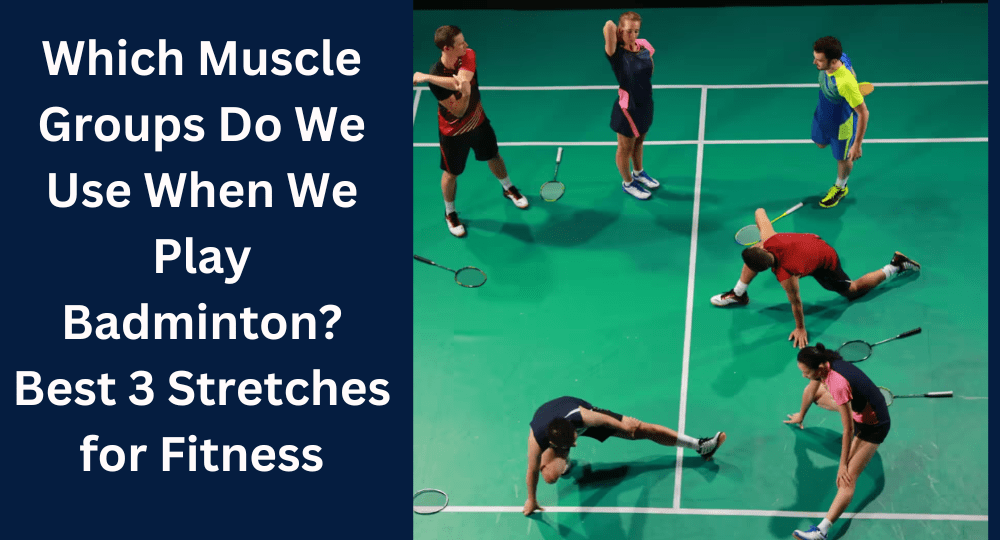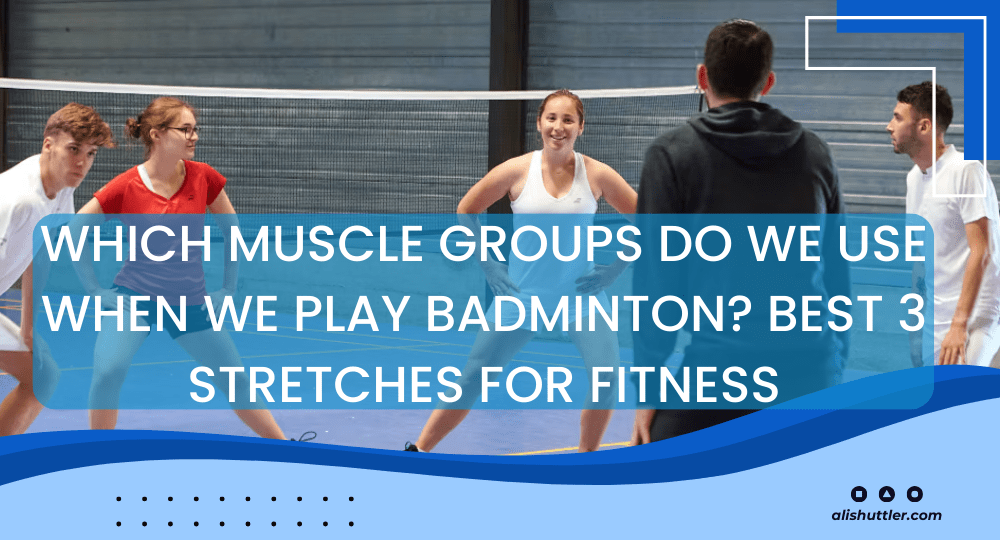Have you ever wondered which muscle groups come into play when we engage in a fast-paced game of badminton? Well, the answer might surprise you. Badminton isn’t just about quick reflexes and agility; it also provides a fantastic full-body workout. By understanding the specific muscles used in badminton, you can enhance your performance on the court.
Badminton combines dynamic upper and lower body movements that activate various muscle groups. From your arm muscles powering those powerful smashes to your leg muscles propelling you across the court, every muscle plays its part. Even those abductor muscles responsible for lateral movements get their fair share of action.
So, whether you’re aiming to build strength or improve endurance, badminton targets multiple muscle groups simultaneously. Get ready for an exciting journey through badminton and discover how this sport can help sculpt your body while having fun on the court.
Now let’s dive into which muscle groups are put to work when playing badminton!
Table of Contents
Importance of Strength Training for Badminton
Strength training is an integral part of any badminton player’s routine. It plays a crucial role in enhancing power and explosiveness on the court, allowing players to deliver strong shots and move quickly across the playing area.
One of the key benefits of strength training is its ability to prevent injuries during intense badminton matches. By building strength in various muscle groups, players can better withstand the game’s physical demands and reduce their risk of strains or sprains. This is particularly important considering the rapid movements, jumps, and sudden direction changes common in badminton.
Strengthening specific muscles used in badminton can significantly improve overall performance and agility. These muscles include the quadriceps, hamstrings, calves, glutes, core muscles, and upper body muscles such as the shoulders and arms. By targeting these muscle groups through weight training exercises like squats, lunges, deadlifts, push-ups, and pull-ups, players can develop excellent stability and control over their movements on the court.

Incorporating strength training into a regular training regimen can also increase endurance during long matches. Stronger muscles can sustain repetitive actions without fatigue setting in too quickly. This allows players to maintain their performance levels throughout a game or tournament.
To summarize:
- Strength training enhances power and explosiveness.
- It helps prevent injuries during intense matches.
- Strengthening key muscle groups improves overall performance and agility.
- Increased endurance is another benefit of incorporating strength training into a badminton routine.
By recognizing the importance of strength training in badminton and incorporating it into their workouts, players can elevate their game to new heights while reducing their risk of injury.
Key Muscles in Badminton Movements
When playing badminton, various muscle groups are engaged to perform the dynamic movements required for this fast-paced sport. Let’s explore the critical muscles involved:
Quadriceps
The quadriceps in the front of the thigh play a vital role in generating power for jumps and lunges. These strong muscles act as agonists during explosive movements, such as smashing or jumping to reach high shots.
Core Muscles
The core muscles provide stability and control during rapid movements on the badminton court. Engaging the core helps maintain balance and enables players to change direction while maintaining proper form swiftly.
Shoulder Muscles
Shoulder muscles are essential for executing powerful shots and smashes in badminton. The deltoids, rotator cuff muscles, and other shoulder stabilizers work together to generate force and accuracy when hitting the shuttlecock.
Exercises to Improve Muscle Strength for Badminton
- Squats: Strengthen your leg muscles, enhancing your jumping ability on the court.
- Planks: Build core strength, improving balance and stability during gameplay.
- Bicep curls: Target arm muscles, aiding in powerful shots and quick racquet movements.
It’s crucial to have a strong foundation of muscle strength. To enhance your performance on the court, incorporating specific exercises into your workout routine can make a significant difference. Here are some activities that focus on different muscle groups involved in badminton:
- Squats: This exercise primarily targets the lower body muscles, especially the gluteus maximus, and quadriceps. By performing squats regularly, you can develop stronger leg muscles that will improve your jumping ability during gameplay.
- Planks: Building core strength is essential for maintaining balance and stability while playing badminton. Planks engage various muscle groups, such as the abdominals, back muscles, and hip flexors. Incorporating planks into your workout routine will help you stay steady on your feet and react quickly to opponents’ moves.
- Bicep curls: The arm muscles are vital in generating power for shots and executing quick racquet movements in badminton. Bicep curls specifically target the biceps brachii, strengthening these muscles and enabling you to deliver more forceful images with precision.
By including these exercises in your training regimen, you can effectively improve muscle strength related to badminton work. Customize your workout routine according to your fitness level and gradually increase intensity for optimal results.
Stretching for Flexibility and Performance in Badminton
Dynamic stretching before playing helps warm up the muscles and increase flexibility. It prepares badminton players for the intense physical demands of the game. By incorporating dynamic stretches into their pre-game routine, badminton players can optimize their performance on the court.
Some critical dynamic stretching exercises that can benefit badminton players include:
- Lunges: Performing lunges helps to activate and loosen up the leg muscles, including the hamstrings and quadriceps.
- Arm swings: Swinging the arms in different directions helps to mobilize the shoulders and upper body, improving the range of motion during shots.
- Torso twists: Rotating the torso gently warms up the core muscles, essential for stability and power in badminton strokes.
In addition to dynamic stretching before playing, static stretches after a match can aid in reducing muscle soreness. Static stretches involve holding a position without movement for a certain period. This type of stretching helps to relax and lengthen tight muscles.
Here are some static stretches that badminton players can incorporate into their post-match routine:
- Hamstring stretch: Sitting on the ground with one leg extended forward, reaching towards your toes to stretch your hamstrings.
- Shoulder stretch: Cross one arm across your chest and use your other arm to gently pull it closer, feeling a time in your shoulder.
- Calf stretch: Stand facing a wall with one foot behind you. Lean forward while keeping your back leg straight to stretch your calf muscle.
Stretching exercises improve flexibility and enhance overall performance on the badminton court. By increasing the range of motion, players can reach difficult shots more efficiently and move swiftly around the court.
Badminton as a Full-Body Workout: Cardiovascular Benefits
Playing badminton offers numerous benefits, including cardiovascular advantages like those gained from running or cycling. Let’s explore how this sport can elevate your heart rate and promote better health.
- Increased Heart Rate: Engaging in a game of badminton raises your heart rate, resulting in improved cardiovascular fitness. Moving around the court, your heart works harder to pump oxygenated blood to the utilized muscles.
- Endurance Improvement: The continuous movement required during gameplay gradually enhances your endurance. Regularly participating in badminton helps build stamina, allowing you to sustain physical activity for longer durations.
- Aerobic Exercise: Badminton is an excellent form of aerobic exercise that strengthens the lower body and upper body muscle groups. Your arms, shoulders, and back are actively swinging the racket and executing shots.
- Heart Health: The aerobic nature of badminton contributes to better heart health. Regularly engaging in this sport can reduce the risk of cardiovascular diseases such as high blood pressure and stroke.
Body Composition and its Relationship to Badminton Players
Maintaining a healthy body composition is crucial for badminton players to achieve optimal performance on the court. This sport’s high-intensity nature demands a well-balanced physique, with a focus on low body fat percentages.
Badminton players strive to keep their body fat levels low due to the sport’s fast-paced and explosive movements. By reducing excess fat, players can enhance their agility and speed, allowing them to navigate the court swiftly.
However, it is not just about shedding fat; badminton also requires lean muscle mass to generate power and speed in various movements. The upper torso plays a significant role in executing powerful shots, while strong lower body muscles provide stability and balance during quick direction changes.

Players need to develop concentric and eccentric strength to excel in badminton. Concentration on antagonist muscle groups is vital for maintaining muscular balance and preventing imbalances that may lead to injuries. This means equally working on opposing muscles, such as biceps and triceps or quadriceps and hamstrings.
Conclusion
Understanding the role of muscle groups in badminton is essential for improving your performance and preventing injuries. You can enhance your power and agility on the court by focusing on strength training. Key muscles involved in badminton movements include the legs, core, shoulders, and arms.
To improve muscle strength for badminton, incorporate exercises such as squats, lunges, planks, push-ups, and shoulder presses into your training routine. These exercises target the specific muscle groups in badminton and help build overall strength.
Stretching is also crucial for flexibility and performance in badminton. Regular stretching exercises can increase your range of motion and prevent muscle imbalances that may lead to injuries.
Playing badminton offers cardiovascular benefits as it provides a full-body workout. The fast-paced nature of the sport helps improve endurance and stamina while burning calories.
Body composition plays a significant role in an individual’s ability to excel in badminton. Maintaining a healthy weight and reducing body fat can enhance speed and agility on the court.
In conclusion, by understanding which muscle groups are involved in playing badminton, incorporating strength training exercises into your routine, focusing on flexibility through stretching, recognizing the cardiovascular benefits of the sport, and maintaining healthy body composition, you can optimize your performance on the badminton court.
Take action today! Start incorporating targeted exercises into your training regimen to strengthen key muscle groups used in badminton. Combine this with regular stretching sessions to improve flexibility and reduce the risk of injuries. Embrace the full-body workout that badminton offers to boost your cardiovascular health. Remember that maintaining a healthy body composition is vital for optimal performance. Keep pushing yourself to reach new heights in this exciting sport!
FAQs
Which muscles are most important for generating power in badminton shots?
The muscles primarily responsible for generating power in badminton shots are the legs, core, and upper body muscles. Strong leg muscles provide a stable base for explosive movements, while a strong core helps transfer energy from the lower body to the upper body. Upper body muscles, particularly the shoulder and arm, generate racket speed and power.
How often should I incorporate strength training exercises into my badminton training routine?
Including strength training exercises two to three times per week in your badminton training routine is recommended. This frequency allows for adequate muscle recovery while providing enough stimulus for growth and development.
Can stretching help improve my badminton performance?
Yes, stretching can significantly improve your badminton performance. Regular stretching exercises enhance flexibility, which increases your range of motion during shots and reduces the risk of muscle strains or tears. Improved flexibility also enables better court coverage and agility.
Is badminton a good sport for weight loss?
Absolutely! Badminton is an excellent sport for weight loss as it combines cardiovascular exercise with full-body movements. Playing badminton regularly can help burn calories, increase metabolism, and contribute to overall weight loss when combined with a balanced diet.
Are there any specific dietary recommendations for badminton players?
While no specific diet is tailored exclusively for badminton players, it is essential to maintain a well-balanced diet that includes lean proteins, whole grains, fruits, vegetables, and healthy fats.

